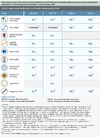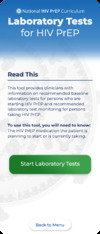There are four medications approved by the United States Food and Drug Administration (FDA) for use as HIV preexposure prophylaxis (PrEP): oral tenofovir DF-emtricitabine (TDF-FTC), oral tenofovir alafenamide-emtricitabine (TAF-FTC), long-acting injectable cabotegravir (CAB-LA), and lenacapavir subcutaneous injections (LEN-SQ). During the baseline evaluation, all persons considered for starting HIV PrEP with any one of these medications should undergo assessment for the following:[1]
- Need for Nonoccupational HIV Postexposure Prophylaxis (PEP): Any significant exposures to HIV in the past 72 hours that suggest a need to immediately start nonoccupational postexposure prophylaxis (PEP) should supersede the plan for starting HIV PrEP. Following completion of nonoccupational PEP, the individual can immediately transition to starting HIV PrEP if indicated. For details on the indications and management of nonoccupational HIV PEP see the 2025 Center for Disease Control and Prevention (CDC) recommendations for management of nonoccupational exposure to HIV.[2] In addition, an updated approach to management of nonoccupational exposure to HIV is addressed in detail in the National HIV Curriculum lesson on Nonoccupational Postexposure Prophylaxis.
- Baseline Laboratory Studies: Prior to starting HIV PrEP, baseline laboratory studies, as outlined in detail in the next section, should be ordered to rule out preexisting HIV infection, to obtain baseline safety laboratory studies, and to evaluate for other important infectious diseases that are transmitted through sexual activity or injection drug use.
- Possible Acute HIV Infection: Any clinical manifestations that suggest acute (primary) HIV infection should prompt a thorough laboratory evaluation for acute HIV infection and should delay the start of HIV PrEP while awaiting the laboratory results. For details on the diagnosis and treatment of acute HIV, see the National HIV Curriculum lesson on Acute and Recent HIV Infection. The figure below summarizes the most common signs and symptoms associated with acute HIV (Figure 1).[1,3]
















